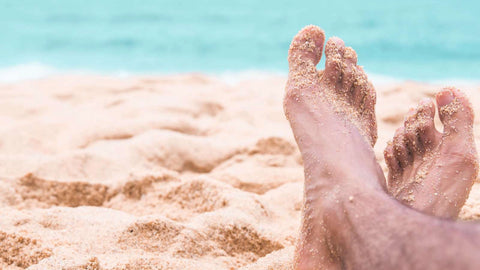
Do you live an active lifestyle? Are you regularly going to the gym, swimming or running? Or do you spend a lot of time in trainers? If so, then you’re probably no stranger to the dreaded Athlete's foot, but fear not, your feet need not suffer in silence, we’ll show you a few simple tips and tricks that’ll keep athlete’s feet at bay.
Athlete’s foot - or tinea pedis - is one of the most common fungal infections in adults. The fungus thrives in warm, dark and humid conditions, usually between the toes, and spreads resulting in an itching and burning sensation that can cause peeling and cracking of the skin.
Like most fungal infections, athlete’s foot is very contagious and can be spread through direct and indirect contact.
This could be through contact with contaminated objects, like walking barefoot on wet floors in public places - changing rooms, showers or swimming pools - but can also spread through contaminated socks, shoes and damp towels.
Wet, warm and sweaty feet are ideal conditions for fungi to live and multiply.
Athlete’s foot lives in and feeds on dead skin tissue. Be sure to wash your feet regularly and wear fresh clean socks and shoes to avoid any chance of re-infection
The pH of skin has been shown to be higher in areas where two layers of skin meet and/or rub together - like your toes. As your skin's pH level rises, the body's natural barrier to infection may be damaged, which could make your skin more susceptible to infection.
The organisms that cause athlete's foot can spread more quickly on cornified and damaged skin - like cuts and grazes - allowing the fungi to attach and multiply.
There are two common types of fungal athlete's foot - found between the toes and the soles of the feet - here are a few signs to look out for:
There are many ways to simply and effectively treat athlete's foot. Scholl’s Athlete's Foot Cream contains a unique antifungal ingredient that is clinically proven to kill fungi and soothe itching in 7 days.
Please note, in order to effectively treat the issue, it’s important to use the products for as long as directed. Your symptoms may disappear, but the fungus could still be present. Should any symptoms persist, please seek expert medical advice.
To ensure you stop athlete’s foot in its tracks, try also using Scholl’s Antifungal Shoe Spray.
This highly effective disinfectant antifungal shoe spray kills 99.9% of the fungus that causes athlete's foot and fungal nail infections. Continued use of Scholl’s Antifungal Shoe Spray will help maintain the hygiene of your shoes and prevent the recurrence of fungus.